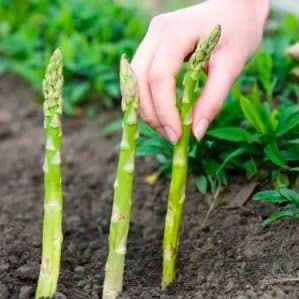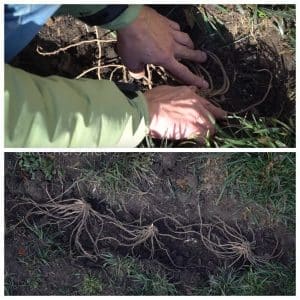When and how to properly transplant asparagus in the fall
Replanting asparagus is necessary for the development and propagation of the crop. The plant can be replanted annually - for the winter.
Why do experts advise replanting asparagus in the fall, and how does this affect development and yield? asparagus, whether there are strict rules for transplantation - read the article.
Why plant asparagus in the fall?
The most common reason for replanting asparagus is to expand the area under this crop. The expensive vegetable has gained popularity among farmers and summer residents. Both of them try to grow as much asparagus as possible for sale and for themselves.
And the autumn period is the most favorable for replanting asparagus to a new place, so that with the first warmth you can already get the first harvest.
Reference. Autumn transplanting of asparagus using the root method increases the possibility of harvesting next year.
Possible reasons for transplantation
In addition to increasing the number of asparagus beds, there are several other reasons for replanting the crop in the fall:
- excessive shading of the area;
- replanting new asparagus bushes;
- replacing old bushes with young ones;
- transplanting into a greenhouse for winter fruiting.
Asparagus is a light-loving plant that requires an area open to the sun.. Summer will tell how well the place was chosen. If the plant has enough light and moisture, it grows quickly and acquires an extensive root system. If the plant is small, yellowish and weak, in the fall it is necessary to transplant it to a more illuminated bed.
The highest productivity of asparagus is observed in the first ten years of the plant's life. Aged asparagus significantly reduces yield, despite ideal growing conditions. After the designated period, the asparagus bushes must be replaced with young ones.
Many gardeners and farmers, wanting to ensure a constant income from the sale of asparagus, organize the cultivation of the crop in a greenhouse method. In the fall, the vegetable is transplanted into greenhouses in order to begin collecting shoots in the middle of winter.
When to replant asparagus in the fall to a permanent place
The timing of asparagus transplantation depends on the region: in the southern regions the procedure is carried out closer to November, in the middle zone and regions located in the north - at the beginning of October or at the end of September.
Agronomists advise focusing on the appearance of the plant and starting replanting after its above-ground part turns yellow.
It is important to complete the “moving” 2-3 weeks before frost.
Preparatory stage
You must first select the most promising plant roots for replanting and conduct an analysis of the soil and location of the beds.
Reference. Loose sandy loam soil rich in nutritious organic matter is suitable for growing asparagus. If the soil is not fertile enough, there is a risk of getting fibrous and tasteless shoots.
Place and soil
Asparagus bushes can grow in one place for up to 20 years. This means that you need to choose a place in the same way as for a bush or tree - for a long time.
The ideal area for planting asparagus is open to sunlight (or slightly shaded as an option) and rarely visited.
One of the best predecessors for asparagus is potatoes. You can use beds after other crops that required deep digging of the soil.
Algorithm for preparing beds:
- Choose a suitable location.
- Fertilize the soil with organic matter: 1-2 buckets of manure, compost or humus per square meter.
- Dig up the beds.
- Remove all weeds from the area allocated for asparagus.
When preparing the area, problems may arise: unsuitable heavy loamy soil, too acidic soil or close groundwater.
What can be done:
- To lighten the soil, it is necessary to adjust its composition by adding coarse sand. The normal state is when wet soil stops sticking together into a lump.
- You can deoxidize the soil with lime, bone meal or dolomite meal, but before doing this, you need to measure the pH of the soil using litmus paper.
- The occurrence of water at a depth of 1.5-2 square meters from the ground surface is considered close. Such a neighborhood is dangerous even for moisture-loving asparagus, since it can cause rotting of the root system and significantly reduce yield. High beds will help save the situation. It is enough to raise them by 10-20 centimeters to provide the plants with comfortable conditions.
Parameters of the beds for asparagus: grooves for planting rhizomes - 30x30 (depth and width), distance between the beds - 50 cm.
Important! When planting in autumn, it is necessary to place a mound over each root to protect the plant from winter frosts.
Planting material
Autumn planting of asparagus is carried out by dividing the roots. In order to get strong, healthy plants that can bear a lot of fruit in the future, you need to pay enough attention to the planting material.
Criteria for choosing rhizomes:
- healthy and strong in appearance;
- full and large;
- brownish-grayish in color (elite varieties vary in shades and can be purple or white);
You need to buy or dig up planting material no earlier than the day before planting. Before planting, the roots are soaked for 15-30 minutes in warm water or compost solution.
To divide the bush, choose a male plant (without seed pods - the famous red berries), 4-5 years old. Male bushes produce many times more commercial asparagus. The bush must be divided into plots and planted every 40-50 cm.
Each shoot has a chance to become a separate plant - it is carefully separated from the parent bush along with its roots.
This is interesting:
Why is asparagus good for weight loss and how to eat it correctly when fighting excess weight.
Is it possible to eat asparagus while breastfeeding and how to cook it correctly.
How to properly replant asparagus in the fall
Planting asparagus in the autumn is the right decision. In summer, it is better not to disturb the plant, although there is an opinion that asparagus easily tolerates the planting process in any season. And spring replanting is a deliberate delay in harvesting for a year.
What does that require
After choosing a location and preparing planting material, you need to calculate the number of rhizomes per available area. It is recommended to place no more than 4-5 roots per square meter, taking into account the branching of adult plants.
Care must be taken during replanting to ensure that asparagus bushes do not interfere with each other’s growth.
Necessary actions when transplanting asparagus in the fall:
- Check the area for fungal spores and weed roots. It is important that neither one nor the other remains: weeds can become entangled between the roots of the asparagus, and it will be difficult to remove them, and a fungus can settle on the crop and destroy it.
- Make sure the area is protected from drafts and wind.For the same reason, seeds and spores are most often spread by winds.
- Loosen the soil.
- Determine the acidity level.
Soil acidity may vary in different places within the same area. For an accurate determination, several samples are taken at a depth of 20-30 cm.
Algorithm for further actions:
- dilute the soil in water (preferably rain) to the state of liquid mud;
- dip litmus paper into the liquid;
- immediately attach the piece of paper to the scale;
- if the color has not changed, it means the soil is slightly acidic, that is, suitable for asparagus.
Step-by-step instructions: how to replant
When planting asparagus, it is recommended to consider the direction of the rows. It is better for plants if they “look” to the south.
Direct transplantation is carried out as follows:
- Dig a trench at least 30 cm deep.
- The bottom of the trench is made spacious and flat.
- If the soil at the bottom is too dense, it is loosened.
- Fill the holes with a layer of humus (up to 10 cm).
- The soil removed during the trench digging process is poured on top of the fertilizer in the form of a ridge (the top of the ridge should not protrude from the hole)
- The seedlings are laid out along the ridge at a distance of 40-50 cm from each other.
- Spread the roots along the slopes of the embankment.
- Cover both the roots and the entire trench with soil. Leveling.
- Generously water and mulch the area.
Read also:
How to quickly and tasty cook canned asparagus.
What is good about frozen asparagus and how to cook it correctly.
What is soy asparagus, how is it useful and how to use it correctly.
Care after transplant
After autumn transplanting, asparagus needs watering. Not as intense and frequent as in the spring-summer period, but the humidity regime must be maintained.
In order for the plant to take root before the cold weather, freshly planted asparagus is watered once every 4-7 days at the rate of 3 liters of water per bush. After each watering, the soil is loosened to avoid stagnation of moisture and the formation of mold.
Asparagus planted in autumn is not fed, because it receives a full range of fertilizers when transplanted. This will last her until spring.
The first organic feeding of autumn asparagus is carried out in mid-May: 1 kg of manure per 5 liters of water. Apply at least 2 liters of solution per plant.
A total of four feedings are done per season. Chicken manure is used for organic matter, and superphosphate is used for mineral fertilizers.
The row spaces are kept exemplary clean. The penetration and growth of weeds harms asparagus, reducing its yield and causing plant diseases or pest infestations.
To prevent weeds from entering the site from the street, a piece of slate or iron is buried on the side of the fence to a depth of 0.5 meters.
Attention! Constant weeding and loosening of the beds is the key to a high yield.
After the autumn transplant, the asparagus is hilled up so that the plants overwinter safely and without loss.
Conclusion
Despite the enormous popularity of the royal vegetable in the world, it is little cultivated in Russia, and the agricultural technology of asparagus has not yet been thoroughly studied by most summer residents and farmers.
For high yields, it is enough to follow simple instructions for replanting, watering and fertilizing the crop. Choose sunny, windless areas, check the acidity of the soil, apply fertilizers in a timely manner and fight weeds.
The principle of growing asparagus is no different from growing other plants: maintain cleanliness of the beds, temperature and humidity conditions.This is quite enough to successfully grow high-quality vegetables in small and large areas.